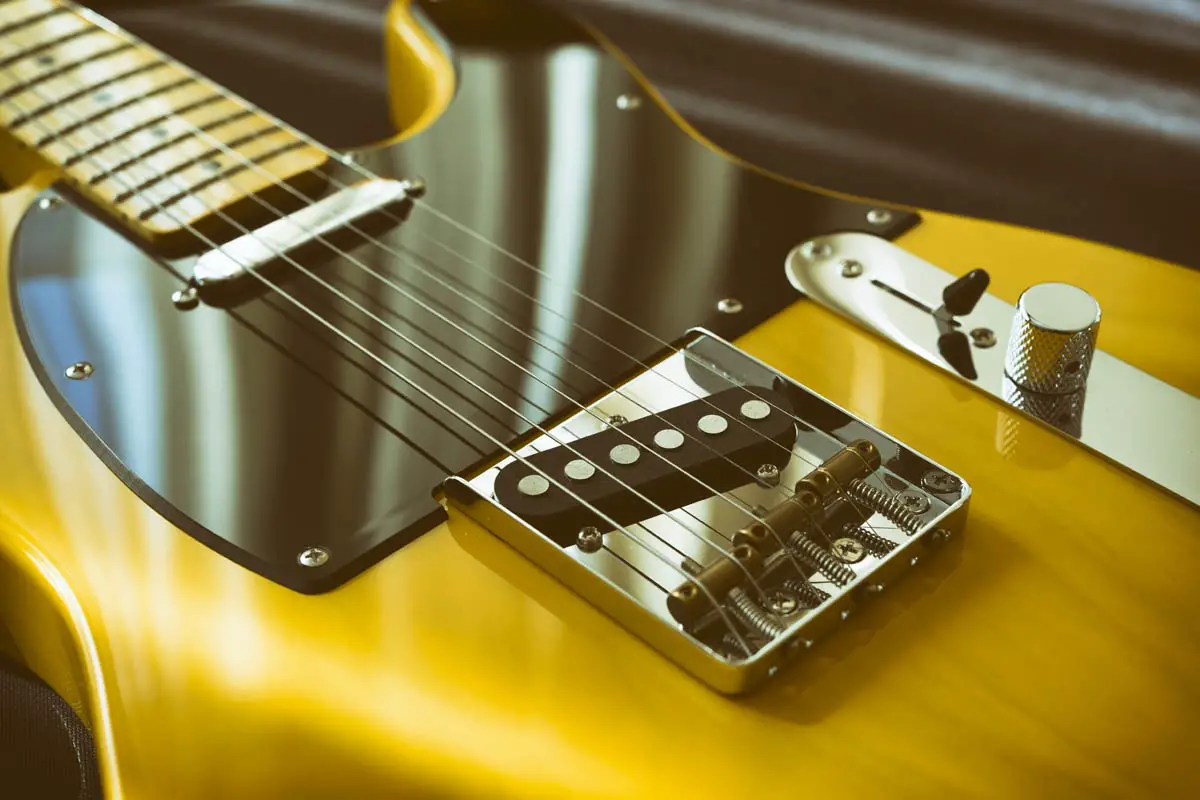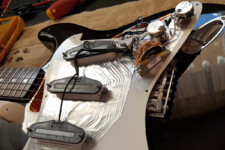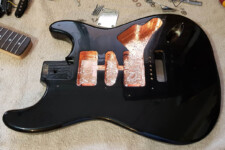How to Connect a Guitar Ground Wire to 5 Bridge Types
For most guitars a ground wire to the bridge is a must to cut background hum while you play.
With single coil pickups this is more important than with shielded humbuckers, or active pickups where the preamp circuitry already removes unwanted noise.
Electric guitars still work fine without a ground-wired bridge, but there are some downsides.
This short guide will look briefly at the pros & cons of ground-wiring your guitar bridge, and then show you some common ways to ground your guitar.

Is a Guitar Bridge Ground Wire Necessary?
Grounding your bridge is not absolutely necessary if your guitar is well shielded and doesn’t normally hum much when you are not touching the strings.
If your amp hums when you plug your guitar in, and stops humming when you touch the strings, then you know there is already a ground wire to the bridge.
Most electric guitars have passive pickups which all hum to some degree, but as you probably know, single coil pickups hum the most. Bridge ground wiring is a must for these guitars if you want the cleanest sound possible.
For guitars with active pickups it’s not really necessary to ground the bridge, but there is no harm in doing it anyway.
What Happens if You Don’t Ground a Guitar Bridge?
As I’ve discussed already, most electric guitars with passive pickups will have some level of 60Hz hum at the amp. If you don’t ground the bridge, then this hum will continue even when you touch the strings.
If you have weather conditions that are dry, you can easily build up a static charge that will be transferred into the strings and bridge when playing. Without a ground-wired bridge this static charge can find its way back to your electronics in bursts, and be heard as crackling.
Although it is very important to have a good ground from your guitar’s electronics back to the amp for safety, this doesn’t actually include the bridge and strings.
If your strings are grounded via the bridge, then you become part of the electrical circuit when you touch them. Without a ground wire to the bridge you are isolated from the electrical circuit when touching the strings, and it could be considered safer in that respect.
Where Does the Bridge Ground Wire Go?
In general, the bridge ground wire will connect back to the metal housing on the back of a volume or tone pot.
This of course relies on the pot itself being connected along the ground path in your guitar, which should always be the case for a properly working electric guitar.
Some guitars could be wired with a central ground post, and have all ground connections star-wired from that post. In that case you would run your bridge ground wire back to the central earth post.
How to Connect A Ground Wire to the Bridge
This will depend on what type of bridge you have in your guitar, and whether there was a ground wire installed when it was made.
Surprisingly some electric guitars were made without a ground wire, and may not even have a hole to run a wire through, so you may need to drill one yourself.
On all guitars, the ground wire will start from a pot housing or earth stud in the electronics cavity, and go through a small hole toward the bridge.
Note that some bridges are powder-coated, and you might need to remove a little where the ground wire touches the bridge, and also where the ball-end of the strings touches the bridge.
Let’s run through a few different bridge types, and how to connect a ground wire to each one.
How to Ground a Stratocaster Tremolo Bridge
The normal way to connect a strat-style tremolo bridge to the earth wire is by soldering the wire to the tremolo claw.
Ensure you use a 40-50 Watt soldering iron at a minimum, or you won’t be able to get the area hot enough to attach the solder to the claw.
The electrical connection passes through the tremolo springs to the bridge.
How to Ground a Telecaster Bridge
Telecaster bridges are designed to add shielding around the bridge single coil pickup, so if the ground wire has broken you will notice far more hum from your amp.
The best way to ground a Telecaster bridge is to remove it from your guitar, and solder the ground wire directly under the plate where the cavity is.
You will need a soldering iron of around 40-50 watts since the bridge plate acts like a giant heat sink, and a lower wattage iron won’t fuse the solder to the plate well.
If you don’t have a soldering iron, then you can expose an inch of wire (remove the plastic insulation), fold it in half, and place it on the body where it will contact the fitted bridge plate.
How to Ground a Les Paul or Wrap-Around Bridge
Both Les Paul style, and wrap-around bridges are hardtail bridges that are secured to the guitar body with posts (or studs).
It’s these posts that normally connect the ground wire, and the wire should come from the electronics cavity through a small hole to the post mounting hole.
If your guitar is not earthing to the bridge, then it’s possible the wire is broken off where it touches the stud. You will need to unscrew the bridge from the studs, and then carefully tap out the stud where the ground wire goes.
Remove half an inch of insulation from the wire, leaving the wire exposed at the end sitting inside the post mounting hole. Then press the stud back in and you will have a good bridge to ground connection.
How to Ground a Hardtail Bridge
Hardtail bridges are all basically the same with ground wiring, in that the ground wire is wedged between the guitar body and the underside of the bridge.
It’s important to have enough wire to firmly contact the bridge, and also to not have any of the wire insulation caught under the bridge also.
If you have a painted bridge, then make sure to scrape away a small section of paint where the wire touches it for a good electrical connection.
How to Ground a Floyd Rose Bridge
Floyd Rose tremolo bridges are attached to the guitar body with posts the same as with stop-tail bridges and wrap-around bridges.
So the method of connecting a ground wire is the same, just pass a wire through a small hole to the post mounting hole, expose some wire, and press the post back in so that the wire contacts the post.
How to Test a Bridge Ground
- The best way is with a multimeter set to Continuity. Hold one probe on the bridge, and the other on the metal housing of the output jack (it doesn’t matter which probe goes at each end). If you get a reading of close to zero ohms (or beeping if your multimeter has that function), then you have a good ground connection.
- Another way would be to have a battery with an LED or small light globe, and connect them with some wires. Then touch one wire on the bridge, and the other on the output jack housing to see if the globe lights up.
- If you don’t have any tools you can as a last resort just listen to your amp turned up so that it hums, and try touching the bridge to hear if the hum reduces. If it does, then you have a ground connection, if the hum doesn’t change then the ground connection is broken somewhere.
What’s the Best Guitar Ground Wire Gauge?
Most internal electric guitar wiring is done with 22AWG gauge multi-stranded wire, or sometimes even a little thicker.
Some benefits of this wire gauge and type are:
- Easy to find in stores.
- Flexible for bending and putting through small holes.
- The multi-strands make it resistant to breaking.
- Easy to solder with smaller soldering irons.




